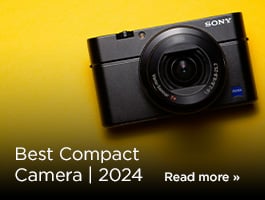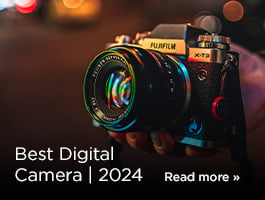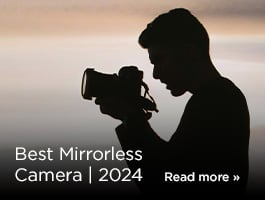
Time-lapse photography is the art of taking single frames and combining them to create a video sequence that shows the movement of time and space much faster than we are used to seeing with our own eyes.
This effect can be created in a number of ways. One popular method is to film a scene for a few minutes or hours and speed it up in editing software; another is to capture a sequence of still images, which are then sequenced together in editing to create a video. Either technique is perfect for capturing dramatic videos of slow-moving objects like clouds, tides, or even an artist painting a picture.
Time-lapse may look difficult and complicated at first glance, but it’s easier than you may think. In this guide, we’ll take you through everything you need to know about making time-lapses, from the kit to buy to the software to use for your final export.
How to create a time-lapse video: Equipment
There are four basic things you need when it comes to shooting your time-lapse images.
DSLR or mirrorless camera
You can use any camera to create a timelapse. Although if you select one with a built-in intervalometer (such as the Olympus OM-D E-M10 Mark IV or the Nikon Z50) then you won’t need to purchase this separately.
Lens
Most time-lapse subjects would suit a wide-angle focal length, but your subject might be better captured with a different focal length.
Intervalometer
Even though many cameras offer built-in intervalometers, some time-lapse shooters prefer to use a dedicated remote release with this functionality as it can be easier to make small adjustments to your intervals without having to dive into the camera menus every time. Check that a given remote control offers interval shooting before buying.
Tripod
A sturdy tripod is essential for capturing a series of images from exactly the same viewpoint.
Optional: ND filter
While not strictly necessary, an ND (neutral density) filter can give fantastic results. It blocks out light into the lens, meaning you can shoot at slower shutter speeds and add motion blur to the moving subjects in your images. This can give the finished time-lapse a smoother look.
Time-lapse technique #1: video
The easiest way to make a timelapse is to simply film your scene for a certain amount of time and then speed this clip up in post-production. Generally a few minutes is the minimum amount of time you want to be making into a time-lapse. The key rule – and this is true for all three techniques – is to use a sturdy tripod, as any shake or vibrations in your video will be amplified when it’s sped up.
Calculating the duration of your time-lapse is easy with this method, as you speed up your clips in percentages. A 10-minute video clip sped up by 200% will end up being a 5-minute video.
Time-lapse technique #2: intervalometer
The second technique is slightly more advanced but can result in much more professional-looking footage. The key is a device called an intervalometer. This accessory plugs into your DSLR or mirrorless camera and allows it to take images with consistent intervals between them. In post, these images can be strung together to make a smooth-looking video time-lapse.
Interval: How long you want to make your time-lapse will determine the interval you set between the images you capture. For example if you are filming a five-hour sunrise, you could use an interval of one minute between captures. If you are recording something that moves faster (like a crowd of people) for just a few minutes, you could use an interval of 10 seconds between each photo.
Format: This will really depend on how much you want to push your footage in terms of the colour grade when you get into the edit. If you shoot JPEG rather than RAW, you’ll take up less storage space, but the compressed format will mean you can’t push it too far. If you want full flexibility and are fine with the extra storage space requirements, shoot RAW.
Duration: If your project is in 25 frames per second, you will need to take 25 images to fill that one second. So to create a 5 second time-lapse you will need 125 images. There are plenty of time-lapse calculators online if you need some help.
Merging the images: Now you have hundreds of images, you need to string them all into a video clip. This is easily done on Adobe Premiere Pro by opening the import window, selecting the first image of your time-lapse, ticking the “Image Sequence” box, and then importing. Your timelapse should now be imported as a video file ready to use.

Time-lapse technique #3: Hyperlapse
A hyperlapse is a time-lapse with moving shots; for example, a sliding camera motion from left to right. For ultra-smooth and professional-looking results, your best bet is to use a camera slider. However, not all photographers have access to one of these, and if that’s the case, then a cost-effective solution can be to use an intervalometer and physically move the tripod between each image taken.
Here is how to create a hyperlapse without a slider:
Intervals: Set the intervals so that you have enough time to move the tripod in between each image (20-30 seconds works well).
Tripod movement: The key ingredient to a hyperlapse is the camera movement. To get smooth-looking motion, you want to set up your tripod on level ground then decide on a distance to move it between each image.
A good way to measure distance is with your feet; a whole foot or half a foot’s distance looks quite natural. You also want to move the tripod in a smooth and consistent direction to avoid creating nauseating movement. Finding a guideline on the floor, like paving slabs or a curb, will help you create smooth movement.
Reference point: One of the most important factors is having a reference point. This is a part of your image you always frame in the same place for every shot as the camera moves, meaning your time-lapse stays stable and doesn't jitter.
A good way to line up a reference point is to use the grid on your camera’s LCD screen. In the image above, you can see the framing has been composed so the top of the house is lined up in the upper-right cross-point of the camera’s grid. If you make sure this remains the same for every photo, the final time-lapse should come out smoothly.
Things to remember: You should be careful you have enough room to move your camera and tripod the direction you want it to go, and don’t forget to check your memory card and battery are ready to go before you start.
How to create a time-lapse: process
Once you’ve got your gear, you’re ready to shoot your time-lapse. Getting a successful time-lapse is highly dependent on two key things — planning and preparation. Here’s how to maximise your chances of success.
Time-lapse planning
When planning your shot you need to consider the movement of the subject before anything else. Are you going to see much of a difference over time or will everything stay the same? Planning your shot and picking a subject in a scene that changes over time will make for a more interesting result. This could be anything like the sun setting, traffic moving in a city or the change in weather.
Remember that photographic rules still apply to time-lapse photography, so make sure you don’t overlook composition. Consider framing your shot using the rule of thirds and try to look for interesting leading lines, and always make sure there are no distracting elements in your shot.
You need to plan your shot just like you would for any stills photography shoot. Once you’ve settled on your location, check the weather and make a note of when the sun sets and rises. Knowing what kind of shot you’re after before you reach the location will enable you to concentrate on the shot instead of running around not knowing what to shoot. When shooting a time-lapse video, the shots can take a long time to process — anywhere from 10 minutes to as long as you like — so planning is crucial if you’re to get your shot in the limited time you have.

Time-lapse setting up
When setting up your shot there are a number of things to remember so that you don’t have a ruined shoot. You first need to consider how long you want the camera to be running, as well as the interval to set between each shot.
While you can set the frame rate of your final video to whatever you like, a good frame rate to start out with is 25fps. So, in this case, 24-25 shots will equate to 1 second of video.
As far as interval times go, a good way to judge is to look at how fast your subjects are moving. If you’re fast-moving clouds, for example, you should only need an interval of 2-3 seconds. However, if you’re photographing the night sky or a slow movement of tides, an appropriate interval could be around 30 seconds.
The chosen interval is really up to you, but through experimentation, you should be able to understand what works best for a particular scene or subject.
Here’s a quick checklist of steps to take when setting up for a time-lapse:
- Attach the camera to the tripod, pushing the tripod into the ground so that it is more secure. On windy days, you may want to attach your backpack to the tripod via the hook (if it has one) to add more weight.
- Attach your intervalometer and dial in your interval settings. If possible, strap the intervalometer to the tripod to stop it from moving in the wind.
- Put your camera in Manual mode. You don’t want the camera to judge the exposure for you, as this will create flickering in your video.
- Check and set your exposure and your focus. This will ensure your timelapse is nice and sharp with no blown highlights.
- If using a DSLR, cover the viewfinder, as stray light leaking through could create flickering.
- When you’re satisfied and ready, click “start” on the intervalometer and leave the camera to do its work.

Advanced time-lapse technique: day to night
If you have experience creating time-lapse videos and want to take your skills to the next level, a day-to-night time lapse is the best way to do it! While your equipment needs will be the same, the technical requirements are a little more complex. This makes day-to-night an interesting challenge for anyone looking to advance their time-lapse skills.
Day-to-night time-lapse: controlling the exposure
As day turns to night, the light levels will change dramatically. This means there is no chance of keeping the exposure the same for all the images, as you likely would if shooting a standard time-lapse. Your exposure will therefore need to be changed to compensate for the amount of light available.
There are two ways in which you can do this — shoot in manual mode and change the shutter speed at different moments, or shoot in Aperture Priority mode and let the camera work out the exposure for you. Both of these methods can work, but shooting in manual mode works best, especially when shooting the night sky.
Day-to-night time-lapse: process
- Put your camera onto a secure tripod and lock everything down to reduce any camera shake.
- Attach an intervalometer to your camera (some cameras have it built in) and dial in your interval settings. The interval can be whatever you want and can vary depending on the scene and what lens you’re using. For day-to-night time-lapse, it’s a good idea to set the interval higher than 7 seconds, as the exposures will grow longer throughout the time-lapse and you don’t want your shutter speed to be longer than your interval.
- Put your camera in complete manual mode, as you don’t want the camera to judge the exposure for you.
- Check your exposure for blown-out highlights and manually focus the lens to make sure the final image will be sharp.
- If you’re using a DSLR, make sure to cover the viewfinder, as stray light leaking through could change the exposure result in flickering. There’s usually an eyepiece cover attached to your neck strap.
- Take a test shot to see if you’re 100% happy with the image’s exposure, composition and focus. Once this is done, start your intervalometer.
As the time-lapse progresses, you’ll need to adjust the exposure via the shutter speed. A good way to do this is to use a light meter placed on top of your camera, and when the meter starts to show underexposure, adjust the shutter speed in the interval before the next shot. Try to be as gentle as possible when doing this to prevent any camera movement.

FAQs
How do I make a timelapse video?
To create a timelapse video, you’ll need to set your camera to interval shooting mode and capture a series of images over a period of time. You’ll need to experiment with choosing the right interval depending on the subject – for example, a few seconds for moving clouds or minutes for a plants growing. Once you have the shots, use editing software to stitch the frames together into a seamless video.
What settings should I use for timelapse photography?
For the best-looking and consistent timelapses, you’ll need to use manual mode to control exposure, aperture, and ISO. Narrow apertures like f8 or f11 keep more of the scene in focus, while a lower ISO reduces noise. You can adjust shutter speed depending on the effect you like – a slower shutter can add motion blur, creating smoother transitions.
How long should I record a timelapse?
The recording length depends on your subject and the final video speed. For example, to create a 10-second video at 25 fps, you’ll need 250 frames. If shooting clouds with a 5-second interval, this takes around 20 minutes. Make sure you plan your intervals so you capture the full motion without running out of space on your memory card or battery.
What equipment do I need for timelapse videos?
You’ll need a camera with interval shooting or timelapse mode, a sturdy tripod to keep shots steady, and plenty of storage for the images. A remote shutter release or app can help reduce camera shake, and for longer shoots, consider a portable power source to avoid running out of battery.
How do I prevent flicker in timelapse videos?
You can avoid flickering by shooting in manual mode and disabling auto settings like white balance and ISO. The key to consistent exposure across frames is to lock your aperture and shutter speed. Then, when editing, use your editing software to smooth out levels.










